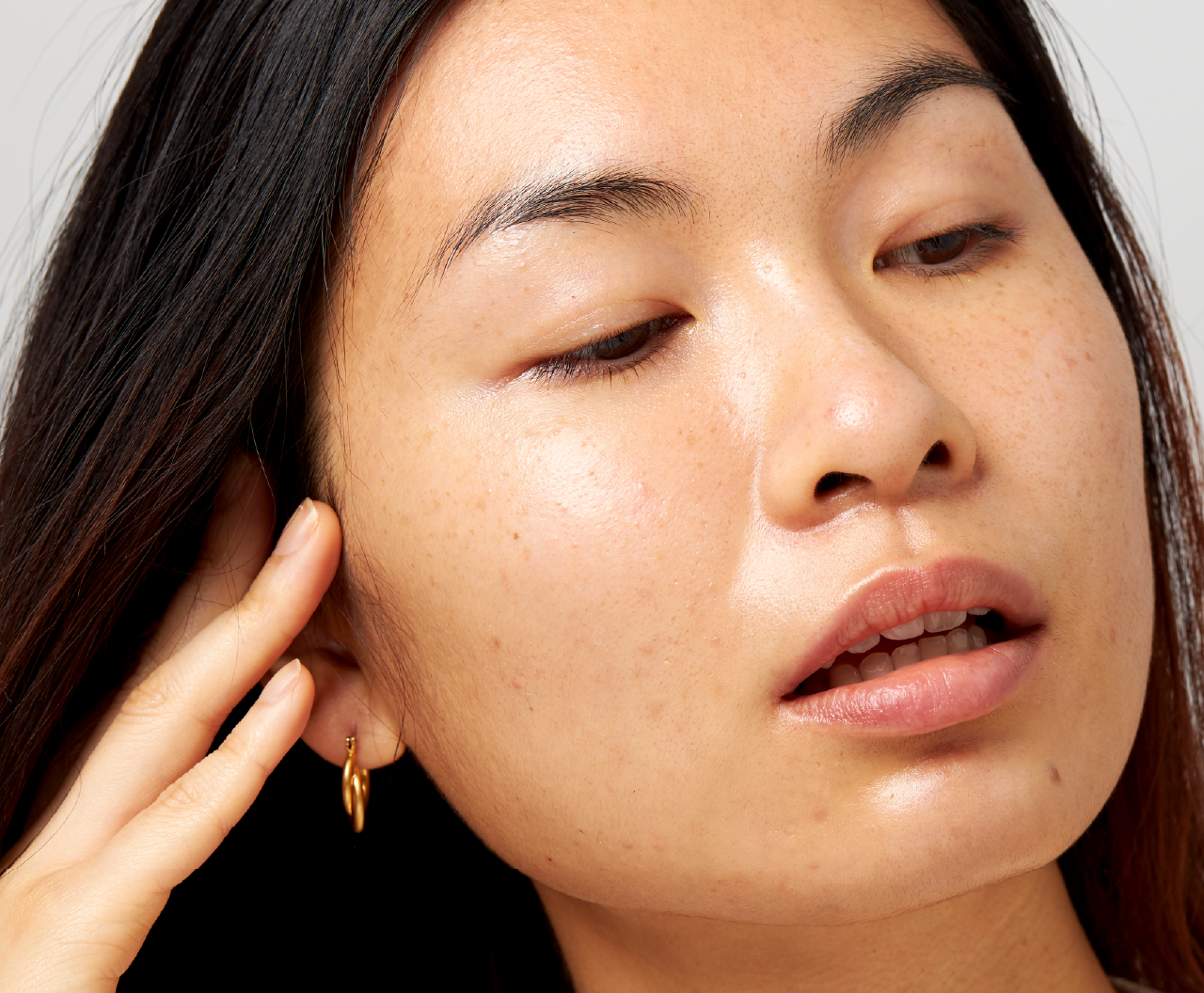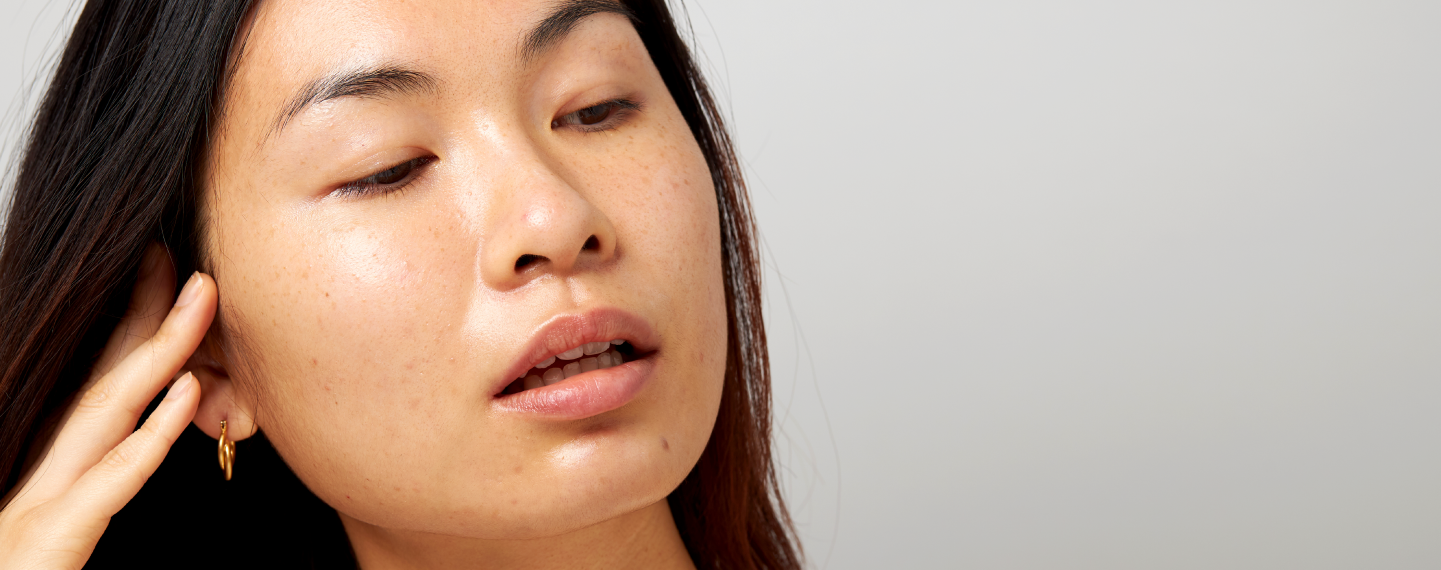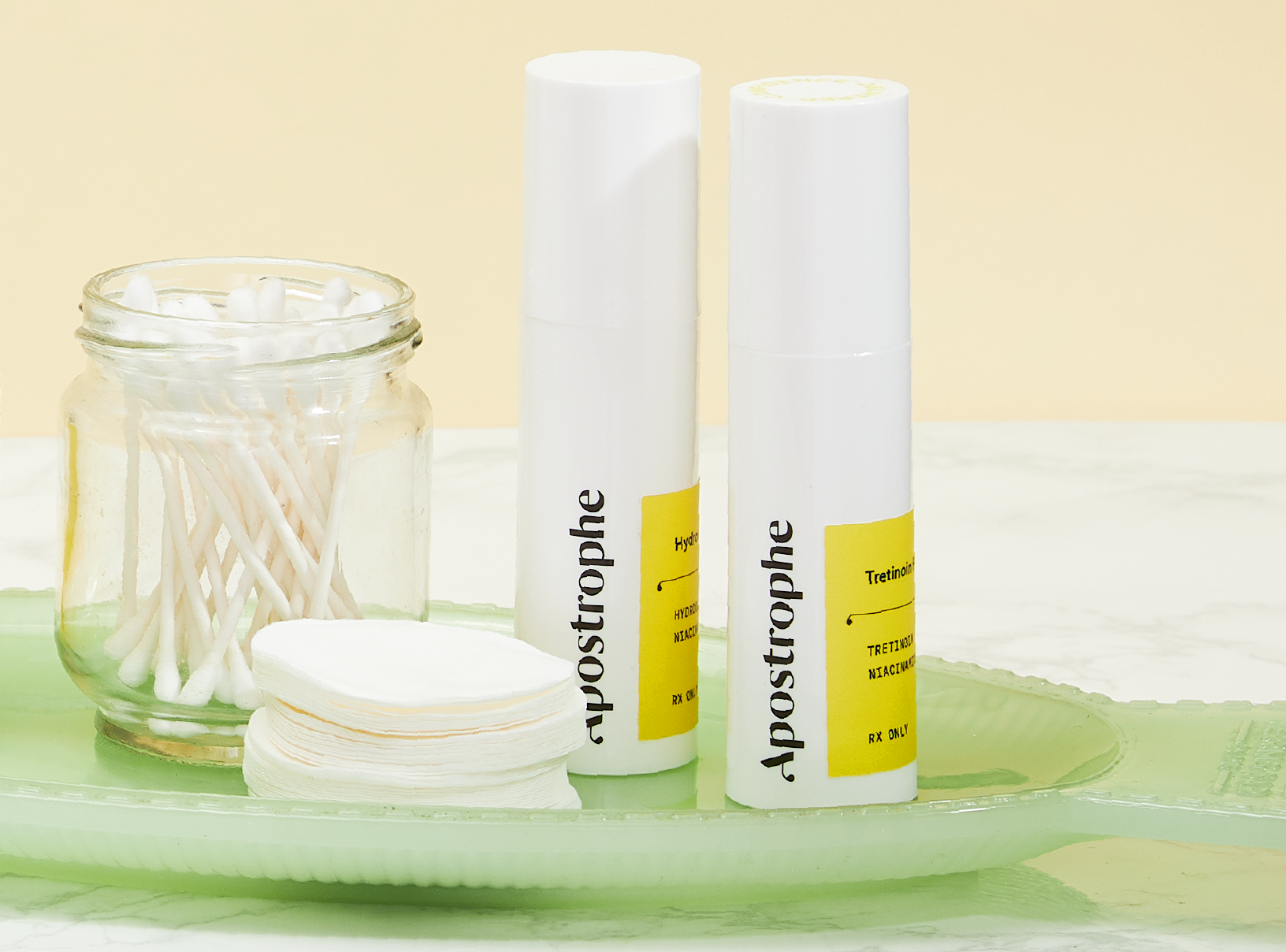Education
How to get rid of acne marks


SHARE
Education
How to get rid of acne marks
Medically reviewed by Mary Lucas, RN
Written by Apostrophe Team
Last updated 4/1/2024
Wherever you are in your journey with acne — whether you’re working to get your skin to a healthier state or have succeeded in settling into a skincare routine that works for you — you may find yourself with lingering acne marks.
Research on the frequency of acne scarring is limited, but around one percent of those who have dealt with acne-prone skin experience scarring.
Severe scarring has additionally been shown to cause a significant amount of physical and psychological distress, particularly in adolescents.
We’ve created this guide to detail what you need to know about clearing your acne scars, from treatment options to considerations for different skin types.
Scarring 101
A scar is a natural buildup of tissue that results from your body healing from injury and is primarily driven by collagen production.
Collagen is the protein that makes up seventy-five to eighty percent of your skin.
Scars come in all shapes and sizes, usually starting off red or pinkish in color and then healing to a shade that is slightly lighter or darker than that of the skin.
The appearance of a scar depends upon factors including the treatment of the wound that caused the scar, and the age, genes, and overall health of the person with the scar.
Some scars present no issues after they’ve formed beyond their appearance, while others might itch or be painful.
Types of Acne Marks and Scars
There are two main types of acne scars: raised (hypertrophic) scars, and depressed (atrophic) scars.
A hypertrophic scar will rise above the skin, but does not grow beyond the boundaries of the original wound. These scars are also more common on the back and chest.
Atrophic scars are depressed into the skin, usually resulting from acne on the face, and fall into the following categories:
Boxcar scars: These present as round or oval depressions, or craters in the skin.
Icepick scars: These are deep scars that form small holes in the surface of the skin, making the skin look like it has been punctured with a sharp object.
Rolling scars: These occur when fibrous tissues develop between the outermost and innermost layer of skin, pulling on the middle skin layers to cause a wavy texture.
Another type of scar that may be seen as a result of acne is keloid scars. Like hypertrophic scars, keloids are also raised above the surface of the skin, but have the additional attribute of spreading beyond the boundaries of the original wound.
Keloid scarring tends to be more prevalent in individuals with darker skin.
While depressed and keloid scars can improve with treatment, they will not completely fade.
Lastly, hyperpigmentation is a type of mark that can appear on skin of color after acne has cleared up.
It is not technically a scar as it is the result of the skin producing extra melanin, resulting in dark spots.
Acne Mark Risk Factors
A variety of factors can put a person at higher risk of forming acne marks.
These can include:
Inflammatory acne: This type of acne typically is swollen, reddish, and painful, and has a tendency to penetrate deep into the skin. Inflammatory acne often includes nodular and cystic acne, and left untreated, can further increase the chances of scarring.
Picking, squeezing and popping: Doing any of these things to acne can increase inflammation in the pimples and surrounding areas, and lead to scarring.
Genetics: Having a blood relative with a history of acne marks can be a risk factor for incurring your own acne scars.
Treatment Options for Acne Marks
Acne scars are best prevented from forming by using an acne treatment that works for your skin.
However, there is a wide range of treatments available for reducing the appearance of acne marks already present.
Treatments differ based on your scar type and whether they can be administered at home or need to be performed by a healthcare provider.
Below, we’ve compiled a list of treatment options based on the type of scar you’re aiming to treat.
Consult with your healthcare provider to determine what path might be best for your skin.
Treatments for Depressed Scars
The following solutions are available to help smooth or reduce the appearance of depressed acne scars.
Acne Scar Surgery
This treatment is a minor surgery performed to treat extremely noticeable scars — with the goal to create less noticeable scars that fade over time.
One version of this surgery involves lifting the scar to make it less depressed, while another focuses on breaking up scar tissue to allow the skin to lift, known as subcision.
The surgery is performed while the patient is awake, using local anesthesia to numb the treatment area. This method works best for the treatment of a few depressed scars.
Resurfacing Procedures
There are a variety of resurfacing procedures that remove the top and sometimes middle layers of skin, sloughing off dead skin cells and in turn, promoting the growth of new cells.
These procedures are best for shallow acne scars and work by contouring the edges of scars to reduce their appearance. Deeper scars often require a combination of surgery and resurfacing to reduce their appearance.
Resurfacing procedures include:
Laser treatments: These are best for treating boxcar and rolling scars. Generally, laser treatments focus on either tightening existing collagen or encouraging the production of new collagen.
Chemical peels: These topical treatments are performed in a series over time and work on the layers of your skin to exfoliate older skin to allow for the growth of new skin.
Chemical peels for acne scars include salicylic acid, glycolic acid, Jessner's solution, resorcinol, and trichloroacetic acid.
Chemical peels can have the adverse effect of post-inflammatory hyperpigmentation on darker skin tones, but salicylic acid does not generally present this side effect and is seen as a particularly effective treatment for darker skin tones.
Dermabrasion and microdermabrasion: Both of these treatments work to remove damaged skin and promote the growth of new skin. Their differences lie in the fact that dermabrasion is a more invasive technique that removes the entire epidermis (outer layer of skin), requiring the patient to go under local or general anesthesia, while microdermabrasion only removes the outer layer of the epidermis.
Fillers
When it comes to fillers, think plumping. With this procedure, your healthcare professional will use collagen, your own fat, or another substance to fill acne depressed scars.
While some fillers last between six and eighteen months, others can be permanent. This treatment is not effective on ice pick scars.
Skin Tightening
With this method, your healthcare provider will use radiofrequency over a series of appointments that typically take place about once a month to tighten the skin and reduce the appearance of depressed scars.
If you decide to take this path, it is common to experience some side effects. Many patients report a burning sensation for about an hour after treatment, with their skin appearing a pinkish color for two to three days after treatment.
For a week after skin tightening, it is important to protect your skin with sunscreen every day and apply a moisturizer for one week after treatment.
Skin tightening works best on depressed scars, and can be used to treat ice pick and boxcar scars.
Collagen Induction Therapy
For the collagen-induction therapy method, your healthcare provider will use a handheld, needle-studded roller to puncture the scar in order to encourage your skin to produce more collagen.
This procedure is commonly referred to as “needling” or “micro-needling.”
For most patients, the treatment takes place over three to six sessions, with gaps of two to six weeks in between.
Side effects include swelling and bruising, which normally clears within four to five days. This treatment is safe for all skin colors.
Treatment of Raised Acne Scars
Scar Creams, Gels, and Silicone Dressings
One at-home option for making raised scars less visible with few side effects is the use of scar creams, gels, and silicone dressings to shrink, flatten, and fade scars over time.
These treatments need to be used continuously over an extended period of time, which can introduce some complexity when dealing with scars on the face.
Over the course of use, some individuals find that their skin becomes itchy and irritated — a symptom that usually goes away once the person stops using the product.
Silicone dressings and bandages have been found to be particularly effective, though researchers are unsure of how they work. One possibility is that silicone helps to hydrate the skin.
Laser Therapy
Laser therapy and other forms of light therapy can be used to safely and effectively treat raised scars.
Treatment with a pulsed dye laser (PDL) can help reduce the itch and pain, diminish color, and flatten a raised scar.
An intense pulsed light (IPL) is effective for people with lighter skin tones.
Cryosurgery
Cryosurgery is a process that works to get rid of scars by freezing them in order to kill scar tissue, causing it to gradually fall away on its own.
This process is usually done over a series of sessions alongside corticosteroid injections. The combination generally yields better results than cryosurgery alone.
One side effect of cryosurgery is skin damage that leaves behind permanent light spots on the treated skin. This method is not recommended for those with darker skin tones.
Treatments for Hyperpigmentation
With many of the aforementioned treatments such as laser therapy, some chemical peels, and cryotherapy, hyperpigmentation can be a common side effect.
So what should your approach be if you have hyperpigmentation instead of acne scars?

HYPERPIGMENTATION TREATMENT
Target dark spots and hyperpigmentation with customized prescription treatment.
Treatments for hyperpigmentation include:
Topical depigmentation agents: These can be used on their own or in combination with other treatments to reduce hyperpigmentation on the epidermis layer of the skin. These agents are not as effective on pigmentation that lies deeper, however. The most effective depigmentation agent is hydroquinone, and it is often combined with others including azelaic acid, kojic acid, licorice extract, and retinoids.
Chemical peeling: This is another option for individuals with hyperpigmentation, but it is limited to topical applications that do not encourage the condition to worsen, including salicylic acid and glycolic acid.
SPF protection: Protection from direct sunlight and sunscreen use is important in preventing further hyperpigmentation on dark spots that already exist.
Getting Rid of Acne Marks
There are plenty of treatments available to help reduce the appearance of acne scars and hyperpigmentation.
You may want to consult with a healthcare professional, to determine the best course of treatment for your scars and skin type.
Once you have a plan in place, you’ll be free to move forth with your scar-minimizing skincare routine, and progress on your journey to clearer skin over the long term.
References
Fabbrocini, G., Annunziata, M. C., D'Arco, V., De Vita, V., Lodi, G., Mauriello, M. C., Pastore, F., & Monfrecola, G. (2010). Acne scars: pathogenesis, classification and treatment. Dermatology research and practice, 2010, 893080. Retrieved from https://www.ncbi.nlm.nih.gov/pmc/articles/PMC2958495/
Cleveland Clinic. (2021, March 15). Scars. Retrieved from https://my.clevelandclinic.org/health/diseases/11030-scars
Ogawa R. (2017). Keloid and Hypertrophic Scars Are the Result of Chronic Inflammation in the Reticular Dermis. International journal of molecular sciences, 18(3), 606. Retrieved from https://www.ncbi.nlm.nih.gov/pmc/articles/PMC5372622/
American Academy of Dermatology Association. (2021). Acne scars: signs and symptoms. Retrieved from https://www.aad.org/public/diseases/acne/derm-treat/scars/symptoms
National Health Service. (2019, July 12). Complications acne. Retrieved from https://www.nhs.uk/conditions/acne/complications/
Nilforoushzadeh, M., Lotfi, E., Nickkholgh, E., Salehi, B., & Shokrani, M. (2015). Can Subcision with the Cannula be an Acceptable Alternative Method in Treatment of Acne Scars?. Medical archives (Sarajevo, Bosnia and Herzegovina), 69(6), 384–386. Retrieved from https://www.ncbi.nlm.nih.gov/pmc/articles/PMC4720458/
American Academy of Dermatology Association. (2021). Scars: overview. Retrieved from https://www.aad.org/public/diseases/a-z/scars-overview
American Academy of Dermatology Association. (2021). How to treat acne in skin of color. Retrieved from https://www.aad.org/news/2020-09-10-how-to-treat-acne-in-skin-of-color
American Academy of Dermatology Association. (2021). How to fade dark spots in skin of color. Retrieved from https://www.aad.org/public/everyday-care/skin-care-secrets/routine/fade-dark-spots
American Academy of Dermatology Association. (2021). Acne scars: who gets and causes. Retrieved from https://www.aad.org/public/diseases/acne/derm-treat/scars/causes
American Academy of Dermatology Association. (2021). Acne scars: diagnosis and treatment. Retrieved from https://www.aad.org/public/diseases/acne/derm-treat/scars/treatment
Chandrashekar, B., & Nandini, A. (2010). Acne scar subcision. Journal of cutaneous and aesthetic surgery, 3(2), 125–126. Retrieved from https://www.ncbi.nlm.nih.gov/pmc/articles/PMC4720458/
Handog, E. B., Datuin, M. S., & Singzon, I. A. (2012). Chemical peels for acne and acne scars in asians: evidence based review. Journal of cutaneous and aesthetic surgery, 5(4), 239–246. Retrieved from https://www.ncbi.nlm.nih.gov/pmc/articles/PMC3560163/
Davis, E. C., & Callender, V. D. (2010). Postinflammatory hyperpigmentation: a review of the epidemiology, clinical features, and treatment options in skin of color. The Journal of clinical and aesthetic dermatology, 3(7), 20–31. Retrieved from https://www.ncbi.nlm.nih.gov/pmc/articles/PMC2921758/
Like what you just read? Sign up for our email list to get the scoop on skincare science delivered straight to your inbox.

Deep Dives
A dermatologist shares his thoughts on the recent studies about benzoyl peroxide and benzene.
Read More
Education
What is milia?
What is milia? Today, we’re jumping into one type of bump that you may have heard about most commonly in infants — milia.
Read More
Education
Best moisturizer for acne-prone skin
If you have combination acne-prone skin, figuring out which moisturizer is best for your skin might be tough. In this guide, we break down the best moisturizer for combination, acne-prone skin.
Read More